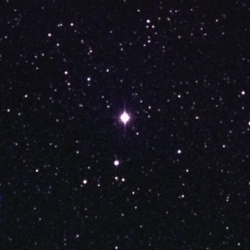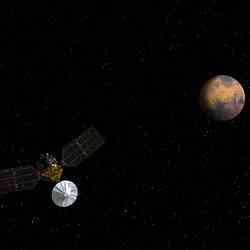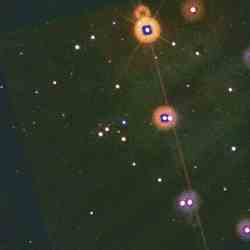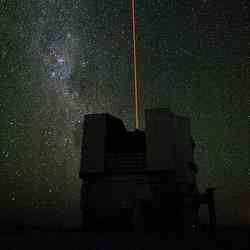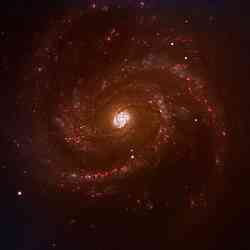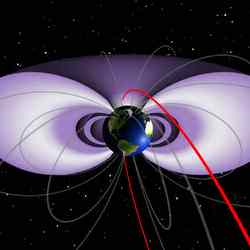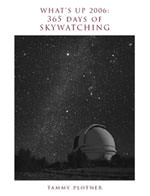
Download our free “What’s Up 2006” ebook, with entries like this for every day of the year.
|
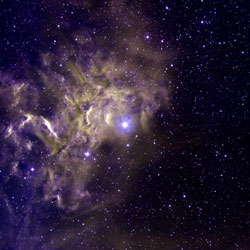
AE Aurigaey. Image credit: T.A. Rector and B.A. Wolpa/NOAO/AURA/NSF. Click to enlarge.
UPDATE: Comet Pojmansk is in the observing news! Now rounding the Sun, it will make its nearest approach to Earth on March 5. At the beginning of the week it averages a magnitude approaching 7 and is brightening fast – possibly coming within unaided viewing range within days. By Monday morning it should reach visiblity for the northern hemisphere and reach a maximum elongation of 22 degrees. Check out a map from SkyHound and be on the lookout!!
Monday, February 27 – Today is the birthday of Bernard Lyot. Born in 1897, Lyot went on to become the inventor of the coronagraph in 1930. Although we cannot hand you a corona, we can show you a star that wears its own gaseous envelope.
Let’s go to our maps west of M36 and M38 to identify AE Aurigae. As an unusual variable, AE is normally around 6th magnitude and resides approximately 1600 light years distant. The beauty in this region is not particularly the star itself but the faint nebula in which it resides known as IC 405, an area of mostly dust and very little gas. What makes this view so entertaining is that we are looking at a “runaway” star. It is believed that AE once originated from the M42 region in Orion. Cruising along at a very respectable speed of 80 miles per second, AE flew the “stellar nest” some 2.7 million years ago! Although IC 405 is not directly related to AE, there is evidence within the nebula that areas have been cleared of their dust by the rapid northward motion of the star. AE’s hot, blue illumination and high energy photons fuel what little gas is contained within the region. Its light also reflects off the surrounding dust. Although we cannot “see” with our eyes like a photograph, together the pair forms an outstanding view for the small backyard telescope and it is known as “The Flaming Star.”
Tuesday, February 28 – Are you ready for a New Moon challenge? Then take advantage of dark sky time to head toward Orion. Tonight our aim is toward a single star – but there is much more hiding there than just a point of light!
Our first stop is the eastern-most star in the “belt,” Zeta Orionis, or better known as Alnitak. At a distance of some 1600 light years, this 1.7 magnitude beauty contains many surprises ? it’s a double star system. High power and steady skies are needed to make Alnitak’s duplicity clear, but if you want more, look a breath east and revisit the Flame Nebula – a fantastic field of nebulosity illuminated by Alnitak. The NGC 2024 is an outstanding region of nebulosity spread over an area the apparent size of a full moon.
Still not enough? Break out the big scope and put Zeta out of the field of view to the north at high power and allow your eyes to re-adjust. When you look again, you will see a long, faded ribbon of nebulosity called IC 434 south of Zeta. It stretches over a degree toward the south. The eastern edge of the “ribbon” is very bright and mists away to the west. Now hold your breath and look almost directly in the center. See that dark notch with two faint stars south of it? You have located one of the most famous of the Barnard dark nebulae – B33.
You may exhale now. B33 is also known as the “Horsehead Nebula.” This “Horsehead” is very tough visually – the classic chess piece appearance of a “knight” is only fully appreciated in photographs – but those of you who have large aperture can see a dark “notch,” improved with the use of a specific nebula filter. B33 is a small area cosmically, only about one light year in expanse. It’s nothing more than obscuring dark dust and non-luminous gas – but what an incredible shape! If you do not succeed at first attempt, try again. The “Horsehead” is one of the most challenging objects in the sky and has been observed with apertures as small as 150mm. This just might be your lucky “Knight”?
Wednesday, March 1 – George Abell was born this day in 1927. Abell cataloged 2712 clusters of galaxies based on the Palomar sky survey completed in 1958. Using plates taken by the 48-inch Oschin Schmidt telescope, Abell put forth the idea that the grouping of galaxy clusters related to the overall arrangement of matter in the universe. He developed the “luminosity function” – correlating brightness and number of members in clusters with distance. Abell also discovered a number of planetary nebulae and developed, along with Peter Goldreich, the theory of planetary evolution from red giants.
With the moon out of the picture early, why not get caught up in a galaxy cluster study – Abell 426. Located just 2 degrees east of Algol in Perseus, this group of 233 galaxies spread over a region of several degrees of sky is easy enough to find – but difficult to observe. Spotting Abell galaxies in Perseus can be tough in smaller instruments, but those with large aperture scopes will find it worthy of time and attention.
At magnitude 11.6, NGC 1275 is the brightest of the group and lies physically near the core of the cluster. Glimpsed in scopes as small as 150 mm aperture, NGC 1275 is a strong radio source and an active site of rapid star formation. Images of the galaxy show a strange blend of a perfect spiral being shattered by mottled turbulence. For this reason NGC 1275 is thought to be two galaxies in collision.
Depending on seeing conditions and aperture, galaxy cluster Abell 426 may reveal anywhere from 10 to 24 small galaxies as faint as magnitude 15. The core of the cluster is more than 200 million light-years away, so it’s an achievement to spot even a few!
Thursday, March 2 – Tonight the Moon appears as a very slender crescent setting to the west in Pisces. This lunar apparition looks very much like a pair of bright horns bearing a dark disk. Such a moon may have given rise to the ancient symbol associated with fertility goddesses originating in Egypt and Mesopotamia. Today we see it “as the old moon in the new moon’s arms.” To see this lunar phase is an Astronomical League challenge.
Skies darken early again tonight, so we’ll have a look at an open cluster easily seen in binoculars and well resolved in small scopes. Start at bright Castor and Pollux in Gemini and turn your eyes, binoculars, or finder scope almost due south to even brighter Procyon. Drop almost the same distance to Xi Puppis. Once you locate Xi, shift the scope or binoculars roughly one finger-width (two degrees) northwest. There you will see a hazy rectangular patch with a handful of barely resolvable stars in its midst – the open cluster M93.
First cataloged by Charles Messier in March of 1781, this wonderfully bright grouping contains a broad range of stellar types among its 80 or so members. Even at a distance of 3500 light-years, binoculars reveal the cluster’s bright haze and sharply angular swatch of core stars and a scope will resolve it. Towards the center, a wedge-shaped collection of bright members congregate. At the heart of the wedge is an easy double star – with another echoing the pair to the west. The very brightest of these stars are young, hot, and blue with an overall stellar population similar to the Pleiades. How old you ask? A very young one million years.
Friday, March 3 – With the Moon near the horizon, we have only a short time to view its features. Tonight let’s start with a central feature – Langrenus – and continue further south for crater Vendelinus. Spanning 92 by 100 miles and dropping 14,700 feet below the lunar surface, Vendelinus displays a partially dark floor with a west wall crest catching the brilliant light of an early sunrise. Notice also that its northeast wall is broken by a younger crater – Lame. Head’s up! It’s an Astronomical League challenge.
Once the Moon has set, revisit M46 in Puppis – along with its mysterious planetary nebula NGC 2438. Follow up with a visit to neighboring open cluster M47 – two degrees west-northwest. M47 may actually seem quite familiar to you already. Did you possibly encounter it when originally looking for M46? If so, then it’s also possible that you met up with 6.7 magnitude open cluster NGC 2423, about a degree northeast of M47 and even dimmer 7.9 magnitude NGC 2414 as well. That’s four open clusters and a planetary nebula all within four square arc-minutes of sky. That makes this a cluster of clusters!
Let’s return to study M47. Observers with binoculars or using a finderscope will notice how much brighter, and fewer, the stars of M47 are when compared to M46. This 12 light-year diameter compact cluster is only 1600 light-years away. Even as close as it is, not more than 50 member stars have been identified. M47 has about one tenth the stellar population of larger, denser, and three times more distant, M46.
Of historical interest, M47 was “discovered” three times: first by Giovanni Batista Hodierna in the mid-17th century, then by Charles Messier some 17 years later, and finally by William Herschel 14 years after that. How is it possible that such a bright and well-placed cluster needed “re-discovery?” Hodierna’s book of observations didn’t surface until 1984, and Messier gave the cluster’s declination the wrong sign, making its identification an enigma to later observers – because no such cluster could be found where Messier said it was!
Saturday, March 4 Born on this date in 1835, Giovanni Schiaparelli opened his eyes (and later ours) to a new world of possibilities – life on Mars. As director of Milan Observatory in 1877, Schiaparelli first described fine, faint features on the surface of Mars as “canali.” Perhaps one of Schiaparelli’s most important contributions was making the connection between meteor streams and the comets that produced them.
Tonight let’s return to our studies of the Moon and a more challenging crater. Further south than Vendelinus, look for another large, mountain-walled plain named Furnerius not too far from the terminator. Although it has no central peak, its walls have been broken numerous times by many smaller impacts. Look at a rather large one just north of central on the crater floor. If skies are stable, power up and search for a rima extending from the northern edge. Keep in mind as you observe that our own Earth has been pummeled just as badly as its satellite.
Sunday, March 5 – Today is the 494th anniversary of Gerardus Mercator’s birth in 1512. The famed mapmaker went on to live a life of great moral courage. Mercator’s time was a rough one for astronomy and astronomers. Despite a prison sentence and threats of torture and death for his “beliefs,” Mercator went on to design a globe of the earth in 1541 and one for the heavens ten years later. One sphere within a larger one – and all without the many complexities envisioned by Ptolemy a millennium before him.
Tonight the Moon provides an opportunity to view to a very changeable and eventually bright feature on the lunar surface – Proclus. At 28 km in diameter and 2400 meters deep, crater Proclus will appear on the terminator to the west of Mare Crisium’s mountainous border. Depending on your viewing time, it will seem to be about two-thirds shadowed, but the remainder of the crater will shine brilliantly. Proclus has an unusually high albedo, or surface reflectivity, of about 16%. This is uncommon for most lunar features. Watch this area over the next few nights as two rays from the crater widen and lengthen, extending approximately 320 kilometers north and south.
Now, just look at the Moon. Can you spot the Pleiades nearby?
Now let’s have a go at the dense open cluster NGC 2301. Located about two finger-widths northwest of visual double Delta Monoceros, this 6th magnitude cluster can be seen in binoculars as a small, faint haze divided by a line of barely resolved stars. Telescopes will reveal a half dozen bright stellar members, plus a number of small clumps of dimmer stars.
Keep rockin’ the night and may all your journeys be at light speed! ….~Tammy Plotner with additional writing by Jeff Barbour @ astro.geekjoy.com
